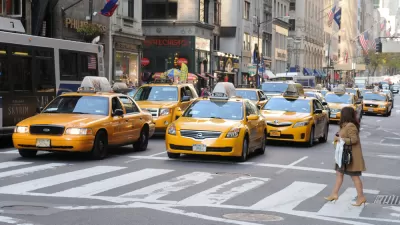MIT’s Senseable City Lab produced a beautiful visualization of every taxi ride taken in New York City in 2011. More valuable than the pretty pictures, however, are the insights the data provide about creating a more efficient transportation system.
Emily Badger shares news of a spectacularly enlightening mapping project called HubCab, by MIT’s Senseable City Lab. “The Senseable City Lab submitted a public records request to the New York City Taxi and Limousine Commission for all its data on those 150 million trips from 2011. They've mapped it in gorgeous, interactive detail,” writes Badger.
“In 2011, there were more than 150 million taxi trips taken in New York City that began or ended in Manhattan, traveling inside 13,586 registered cabs,” according to HubCab’s data, but the patters of those trips reveal redundancies that, at least in theory, help make the city’s taxi system work more efficiently.
For instance, “Taxis ferried passengers from Grand Central Station to near Union Square some 73,000 times, and from Union Square to Grand Central Station 94,000 more.” The obvious question, then, is “what would happen…if we could optimize the entire taxi network in New York as if it were a single, integrated, all-seeing system?” According to HubCab’s analysis, “a totally optimized taxi network in New York would produce 40 percent fewer trips, a similar drop in emissions, and far less traffic.”
What's preventing from implementing improvements to the system now? Although HubCab has done the analysis, someone would have to develop the technology to pair riders. Then there is the loss of business for taxi drivers (who are already under pressure from new forms of technologically-enabled competition) and the fact that many people don’t want to share cabs. "There are psychological barriers," says Michael Szell, one of Senseable City Lab’s researchers. "There are many people who don’t want to sit next to a stranger in a cab. In practice, this percentage would be much lower than 100 percent, maybe more like 10 percent in the beginning."
FULL STORY: How a System for Shared Taxi Rides Could Transform New York City

Study: Maui’s Plan to Convert Vacation Rentals to Long-Term Housing Could Cause Nearly $1 Billion Economic Loss
The plan would reduce visitor accommodation by 25,% resulting in 1,900 jobs lost.

North Texas Transit Leaders Tout Benefits of TOD for Growing Region
At a summit focused on transit-oriented development, policymakers discussed how North Texas’ expanded light rail system can serve as a tool for economic growth.

Using Old Oil and Gas Wells for Green Energy Storage
Penn State researchers have found that repurposing abandoned oil and gas wells for geothermal-assisted compressed-air energy storage can boost efficiency, reduce environmental risks, and support clean energy and job transitions.

Santa Barbara Could Build Housing on County Land
County supervisors moved forward a proposal to build workforce housing on two county-owned parcels.

San Mateo Formally Opposes Freeway Project
The city council will send a letter to Caltrans urging the agency to reconsider a plan to expand the 101 through the city of San Mateo.

A Bronx Community Fights to Have its Voice Heard
After organizing and giving input for decades, the community around the Kingsbridge Armory might actually see it redeveloped — and they want to continue to have a say in how it goes.
Urban Design for Planners 1: Software Tools
This six-course series explores essential urban design concepts using open source software and equips planners with the tools they need to participate fully in the urban design process.
Planning for Universal Design
Learn the tools for implementing Universal Design in planning regulations.
Ascent Environmental
Borough of Carlisle
Institute for Housing and Urban Development Studies (IHS)
City of Grandview
Harvard GSD Executive Education
Toledo-Lucas County Plan Commissions
Salt Lake City
NYU Wagner Graduate School of Public Service





























